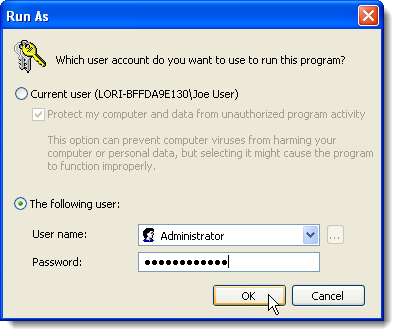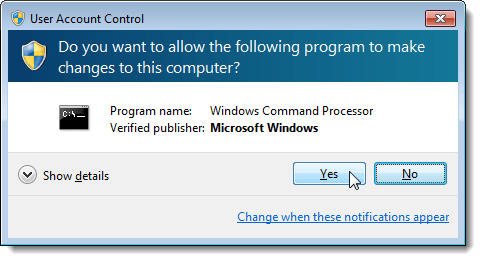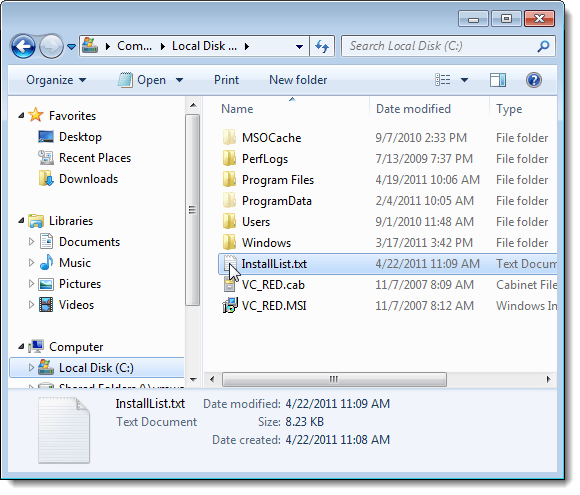If you need to reinstall Windows 7, Windows Vista, or Windows XP for any reason, you may want a list of the programs you have installed on your system so you can easily know what programs you need to reinstall once you have installed Windows again.
NOTE: This procedure shows you how to generate a list of installed programs only. The license keys and serial numbers for the programs are not included in the list. To generate a list of license keys and serials numbers for your installed programs, see our post, Recover License Keys for Installed Software.
To generate the list of installed programs, open the Command Prompt as Administrator. To do this in Windows 7 or Windows Vista, enter “cmd” (without the quotes) in the Search Programs and Files box on the Start menu. The cmd.exe program should automatically be highlighted in the Programs section of the results. Press Ctrl + Shift + Enter to open cmd.exe as Administrator.
You can also open the Command Prompt as Administrator in Windows 7 or Windows Vista by opening All Programs | Accessories on the Start menu. Right-click on the Command Prompt shortcut and select Run as administrator from the popup menu.

If you are using Windows XP, open All Programs | Accessories on the Start menu. Right-click on the Command Prompt shortcut and select Run as from the popup menu.

The Run As dialog box displays. Select the The following user radio button and select Administrator from the User name drop-down list, if it is not already selected. Enter the Administrator password in the Password edit box. Click OK.

If you are using Windows 7 or Vista and the User Account Control dialog box displays, click Yes to continue.
NOTE: You may not see this dialog box, depending on your User Account Control settings. See our post, Windows 7 – How to configure UAC (User Account Control), for more information.

Enter “wmic” (wmic is the Windows Management Instrumentation Command-line tool) at the command line and press Enter.
NOTE: For more information about WMIC, see Microsoft – Using the Windows Management Instrumentation Command-line (WMIC) tool.

Enter the following line at the wmic:root\cli prompt and press Enter.
You can also change the name of the output file and drive letter and path (right after /output:) if you want to modify the output location.

The InstallList.txt file is created on the root of the C: drive.
NOTE: Depending on how many programs are installed, you may have to wait a bit for the list of installed programs to be created. You will know that the list is complete when you get the wmic:root\cli prompt again.

When you open the InstallList.txt file in a text editor, you can view the Name and Version of every program installed on your computer in a nice table.

To exit out of wmic, enter “exit” (without the quotes) at the wmic:root\cli prompt.

To close the Command Prompt window, enter “exit” (again, without the quotes) at the main prompt.

You can also change the name of the output file and drive letter and path (right after /output:) if you want to modify the output location.
by Lori Kaufman
NOTE: This procedure shows you how to generate a list of installed programs only. The license keys and serial numbers for the programs are not included in the list. To generate a list of license keys and serials numbers for your installed programs, see our post, Recover License Keys for Installed Software.
To generate the list of installed programs, open the Command Prompt as Administrator. To do this in Windows 7 or Windows Vista, enter “cmd” (without the quotes) in the Search Programs and Files box on the Start menu. The cmd.exe program should automatically be highlighted in the Programs section of the results. Press Ctrl + Shift + Enter to open cmd.exe as Administrator.
You can also open the Command Prompt as Administrator in Windows 7 or Windows Vista by opening All Programs | Accessories on the Start menu. Right-click on the Command Prompt shortcut and select Run as administrator from the popup menu.

If you are using Windows XP, open All Programs | Accessories on the Start menu. Right-click on the Command Prompt shortcut and select Run as from the popup menu.

The Run As dialog box displays. Select the The following user radio button and select Administrator from the User name drop-down list, if it is not already selected. Enter the Administrator password in the Password edit box. Click OK.

If you are using Windows 7 or Vista and the User Account Control dialog box displays, click Yes to continue.
NOTE: You may not see this dialog box, depending on your User Account Control settings. See our post, Windows 7 – How to configure UAC (User Account Control), for more information.

Enter “wmic” (wmic is the Windows Management Instrumentation Command-line tool) at the command line and press Enter.
NOTE: For more information about WMIC, see Microsoft – Using the Windows Management Instrumentation Command-line (WMIC) tool.

Enter the following line at the wmic:root\cli prompt and press Enter.
/output:C:\InstallList.txt product get name,versionNOTE: There is a space between .txt and product, between product and get, and between get and name.
You can also change the name of the output file and drive letter and path (right after /output:) if you want to modify the output location.

The InstallList.txt file is created on the root of the C: drive.
NOTE: Depending on how many programs are installed, you may have to wait a bit for the list of installed programs to be created. You will know that the list is complete when you get the wmic:root\cli prompt again.

When you open the InstallList.txt file in a text editor, you can view the Name and Version of every program installed on your computer in a nice table.

To exit out of wmic, enter “exit” (without the quotes) at the wmic:root\cli prompt.

To close the Command Prompt window, enter “exit” (again, without the quotes) at the main prompt.

You can also change the name of the output file and drive letter and path (right after /output:) if you want to modify the output location.
by Lori Kaufman



No comments:
Post a Comment